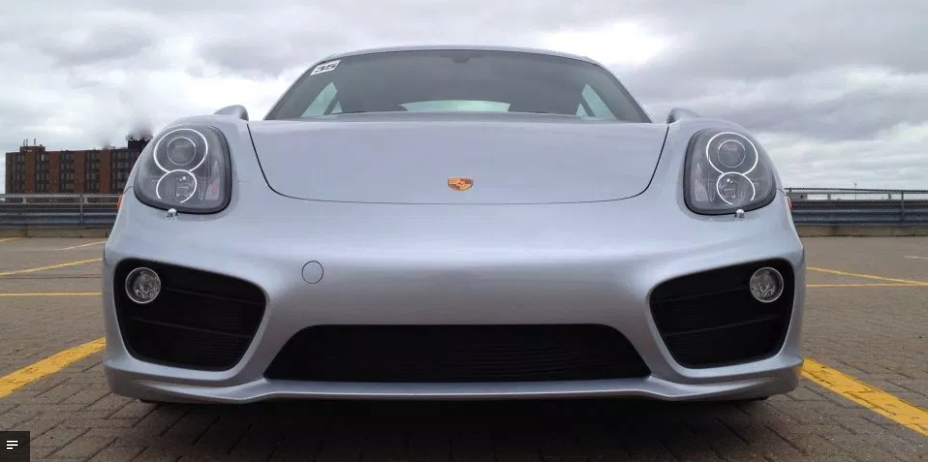Road Test: 2015 Porsche Cayman S

Story and photo by John LeBlanc
Just like the way your parents sagely advised you in high school, popularity is not the sole measure of competence. The same can be said for Porsche’s current lineup.
The most popular Porsche in Canada last year was the midsize Cayenne sports utility vehicle, followed by the Macan compact SUV. The least? The two-seat Cayman, a perennial wallflower that’s arguably Porsche’s last remaining sports car.
From the Sad But True file, along with its equally unpopular Boxster roadster sibling, the Cayman has long been overshadowed by Porsche’s better-selling SUVs and evergreen 911 2+2. But that doesn’t mean the mid-engine rear-wheel-drive sports car does not warrant your attention if you love to drive.
In the mid-1990s, with bitter rivals BMW and Mercedes-Benz set to debut their respective Z3 and SLK entry-level sports cars, financially troubled Porsche needed a quick response. To speed up the process and reduce development costs, Porsche employed the front half of its 911, swapped out its rear seats with a mid-mounted engine, and the entry-level Boxster two-seat roadster was born in 1996.
When the second-generation Boxster was in development, Porsche decided a hardtop/hatchback Boxster would be a good idea, which is how we got the first Cayman in 2006. Just last year, a redesigned second-generation Boxster/Cayman arrived. Yet despite its spot at the bottom of Porsche sales charts, the Cayman lineup is now larger than ever.
Base model Caymans, with a 2.7-litre six-cylinder gas engine that makes 275 horsepower, start for as little as $60,985 (all prices include freight and pre-delivery inspection fees). Added to the lineup in the past year are the $86,885 Cayman GTS (340 hp) and the topline $97,585 Cayman GT4 (385 hp). Sitting in the middle is my tester, the $74,185 Cayman S, using the same 3.4L six-cylinder as the GTS, but delivering 325 hp and the same 280 pound-feet of torque.
With Porsche posting zero to 100 kilometres an hour times ranging from 5.6 seconds for the Cayman 2.7 and 4.4 for the GT4, there’s nary a Cayman you could call “slow.” Purists will want the six-speed manual, but the automatic is actually the faster choice. The Doppelkupplungsgetriebe (German for double-clutch autobox) or PDK, has been available in the Cayman since 2009. For 2015, it’s a worthwhile $3,660 option over the six-speed stick, particularly if your goal is outright speed.
First, you can customize the PDK to your driving mood. Pretend it’s a manual gearbox by shifting gears via its console-mounted gear selector or steering wheel-lounged paddle shifters. Left alone in Drive for casual driving, PDK acts like a sporty autobox, upshifting leisurely between 3,000 and 4,000 rpm. Hit the Sport button, and shifts now held up to more than 6,000 rpm. And downshifts are quicker as well. And when mated with the launch control feature that’s part of the $2,710 Sports Chrono Package, a Cayman S can scoot from rest to 100 km/h in 4.9 seconds — only 0.1 seconds slower than a $97,585 911 Carrera with a stick.
And although fuel economy is likely at the bottom of the priority list of most Porsche purchasers, a Cayman S with a PDK is estimated to sip premium fuel at a rate of only 11.3 litres per 100 km in the city and 7.9 on the highway, slightly better than the respective 11.9 and 8.6 numbers you get with the six-speed manual.
Of course, if you are looking for a $70,000 car to get you to the speed limit as quickly possible, there is Dodge’s low-three-seconds Challenger SRT Hellcat. But when it comes to a curve in the road, few vehicles can carve like Porsche’s sports car.
As the least expensive mid-engine sports car you can buy, the Cayman S has a head start on front-engine rivals like the Audi TT-S, BMW Z4, Chevrolet Corvette, Nissan 370 Z and Mercedes-Benz SLK-Class. With a near-ideal 46:54 front-to-rear weight distribution, there are less centrifugal actions tugging on your intentions when connecting apexes in the Cayman S. And because it shares its front end with the 911, the Cayman also gets its big brother’s electric steering system, a setup that anticipates the driver’s intentions telepathically, with a lovely linearity not found in lesser e-steering systems from other automakers.
Also inherited from the 911 is the Cayman’s $1,510 Torque Vectoring system. Married to a mechanical limited-slip rear differential, the sports car’s computer applies moderate brake pressure to the inside rear wheel when cornering to make up for any lack of driver talent. Combined with its balanced chassis, mind reading steering, and quick-to-react powertrain, it’s hard to find fault with a Cayman S as a vehicle for Sunday morning back road blasts.
Hard, but not impossible. While my tester’s $1,410 Sport Chassis suspension (that drops the already low-to-the-ground Cayman another 20 millimetres) may pay dividends at a table-top smooth race track, here in the Land of Potholes, I was forever slowing down to avoid bending a rim. Other than the lack of ground clearance, when you’re not playing Steve McQueen on an empty back road, Porsche’s sports car has few compromises as a daily driver.
Inside, the Porsche two-seater certainly doesn’t feel any less luxurious than its more expensive 911 sibling. The Cayman S’s large, central information screen, sloping, Porsche 918 supercar-inspired centre console and solid, durable feeling are consistent with the more upscale Carrera. And with cargo holds both out back and up front for a total of 425 litres, the Cayman S can also handle luggage for a dirty weekend away with your favourite partner.
You may have not listened to your parents back in high school. But take it from yours truly: the 2015 Porsche Cayman S is one of the best overall sports cars for the money. Even if no one seems to be buying it.





![[del.icio.us]](https://www.straight-six.com/wp-content/plugins/bookmarkify/delicious.png)
![[Digg]](https://www.straight-six.com/wp-content/plugins/bookmarkify/digg.png)
![[Facebook]](https://www.straight-six.com/wp-content/plugins/bookmarkify/facebook.png)
![[Google]](https://www.straight-six.com/wp-content/plugins/bookmarkify/google.png)
![[Reddit]](https://www.straight-six.com/wp-content/plugins/bookmarkify/reddit.png)
![[StumbleUpon]](https://www.straight-six.com/wp-content/plugins/bookmarkify/stumbleupon.png)
![[Twitter]](https://www.straight-six.com/wp-content/plugins/bookmarkify/twitter.png)
![[Email]](https://www.straight-six.com/wp-content/plugins/bookmarkify/email.png)